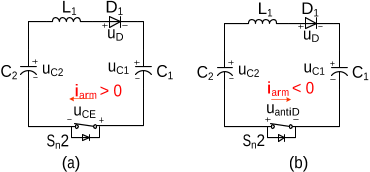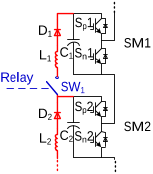Abstract— Multilevel converters have become very
attractive for high voltage-level power conversion in
renewable power generation applications. The converter
topology is an important issue in the studies of multilevel
converter. Many multilevel topologies have been developed,
but few of them are qualified with capacitor voltage
self-balancing capability. This paper proposes a novel
diode-clamped modular multilevel converter (DCMMC)
with simplified capacitor voltage balancing control. In this
topology, low power rating diodes are used to clamp the
capacitor voltages of the converter. Only the top
sub-module in each arm of the converter requires capacitor
voltage control. Consequently, very few voltage sensors are
needed for voltage control and the control computation
burden is reduced greatly when the quantity of the
sub-modules is high. A simple voltage balancing control
method with carrier phase-shifted (CPS) modulation
strategy is developed for this topology. Experiments based
on a laboratory prototype were carried out and the results
validated the capacitor balancing performance of the
proposed topology.
Index Terms— Multilevel converters, diode-clamped modular
multilevel converter, capacitor voltage balancing.
I. INTRODUCTION
IGH voltage-level power conversion and transmission
have become very popular for wind power and
photovoltaic power generation, since the power scale of a wind
farm or a photovoltaic power station is becoming larger and
larger, even over hundreds of MWs. And high-voltage AC/DC
or DC/AC converters are the basic elements in such
applications. With low total harmonic distortion (THD) and
low voltage stress on power switches the multilevel converter is
a good choice for these applications.
Since 1980, multilevel converters have been developed
extensively [1]-[6]. The most famous multilevel converter
topologies are the neutral-point clamped (NPC), the
flying-capacitor (FC) and the cascaded multilevel converters. It
is easy to achieve a three- or five-level converter using the NPC
or FC topology. However, numerous clamping diodes and
capacitors are required when the voltage levels are high.
Furthermore, the capacitor voltage balancing control is difficult
and complicated [7]-[10].
With superior modularity and the least component
requirement among various multilevel topologies, the cascaded
H-bridge (CHB) multilevel converter seems to be the most
Manuscript received ******, ******This work is supported by ******.
suitable for medium-voltage active power conversion [11]-[16].
The voltage of the cells is maintained by isolated dc voltage
source, which can be supplied by wind turbine generator,
photovoltaic-cell, or windings of a multiwinding transformer,
etc. However, the requirement of isolated dc voltage supplies
and energy storage systems is the shortcoming in some
applications. When the CHB converter is applied in reactive
power conversion, e.g., STATCOM [17]-[20], the floating
capacitor voltage balancing control becomes the most
challenging issue.
Over the last decade the modular multilevel converter
(MMC) topology as another kind of cascaded topology has
gained growing attentions and found itself very attractive for
medium/high-voltage applications [21]-[24]. Its modularity and
scalability enable it to meet any voltage level requirement
[25]-[27]. However, like the CHB topology, the capacitor
voltage imbalance distributed in sub-modules (SMs) still
remains. Many researchers concentrate on developing control
and modulation strategies to solve the problem [27]-[39]. The
most widely accepted voltage balancing strategy is based on a
sorting method [27]. Li proposed an improved modulation
method to balance the capacitor voltages [28]. The control
systems rely on voltage sensors installed in all the SMs. In
addition, extra switching actions [29] [30] or high execution
frequency of voltage sorting algorithms [31] [32] are usually
involved, and the situation will deteriorate when the number of
SMs is high [33].
In 2001, Peng proposed a generalized multilevel converter
[38], which can balance each capacitor voltage automatically
without any additional circuits when applied in active or
reactive power conversion. From this generalized multilevel
converter topology, several other multilevel topologies can be
derived including the diode-clamped, capacitor-clamped,
cascaded H-bridge, Marx and modular multilevel topologies
[39]. However, the quantity of components in the general
multilevel converter is too high, which limits its applications in
high voltage-level conversion. The Marx multilevel converter
was proposed by Rodriguez and Leeb in [40], which can also
realize voltage self-balancing at the price of extra active power
switches compared with the MMC.
Based on the Marx and modular multilevel converters, this
paper proposes a new type of multilevel topology in order to
achieve a simplified capacitor voltage balancing method with
modularity and good harmonic performance. In this topology, a
low current rating diode and an inductor are used to replace the
balancing switch installed in each cell of the Marx multilevel
topology. We refer this new topology as the diode-clamped
MMC (DCM2C). In this topology the number of voltage






























